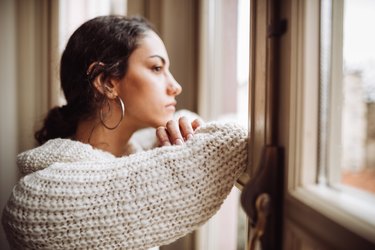
That sad-sluggish feeling that starts to take over as the days get darker and colder is a real thing. And for people with Seasonal Affective Disorder, it takes more than a daily dose of hygge to keep your spirits high.
Seasonal Affective Disorder, often called SAD for short, is a seasonal form of depression that's triggered by seasonal changes, usually as fall gives way to winter.
Video of the Day
Video of the Day
"It presents very similarly to other forms of depression," says Marina Gershkovich, PhD, assistant professor of clinical psychology at Columbia University Medical Center in New York. "You might feel sad or depressed, have less energy or have less interest in the things you normally enjoy."
SAD isn't exactly the same as other types of depression though. These extreme winter blues can drive you to want to eat high-carb comfort foods and sleep more often than usual (sort of like you're going into hibernation mode). And it tends to fade away when spring rolls around and the days get brighter and warmer.
SAD's seasonal expiration date is a good thing, of course. But you'll still need to find something make winter more manageable until those long, sunny days come around again. Here are the science-backed solutions that really make a difference, along with the remedies to skip.
1. Light Therapy
Good EvidenceLight therapy, where you sit in front of a very bright light box first thing in the morning, has been a cornerstone of SAD management for decades, according to the National Institute of Mental Health (NIMH).
"During the winter, you're not getting as many daylight hours from the sun. The light box provides that by mimicking the light you'd get from the sunrise," Gershkovich explains.
You'll reap the biggest benefits by using a dedicated light box designed for SAD for 30 to 45 minutes a day, first thing in the morning, per the NIMH. (Using it in the evening might make it harder to fall asleep.) A box that delivers 10,000 lux, which is about 10 times brighter than standard indoor lights, is best.
2. Cognitive Behavioral Therapy
Good EvidenceTalking with a mental health professional can make SAD a lot more manageable. The most effective form of talk therapy for SAD is cognitive behavioral therapy (CBT), which helps you identify and replace unwanted thoughts, per the NIMH.
"If someone says they hate this time of year, that could be feeding the depression. So instead we'll talk proactively about how to prevent those feelings," Gershkovich says.
For instance, you might brainstorm activities that will keep you engaged throughout the winter — like meeting friends for ice skating or joining a knitting group — to help stave off that I-just-want-to- stay-on-the-couch-and-watch-TV feeling.
3. Antidepressants
Good Evidence"If a light box and talk therapy alone aren't doing enough, or if someone doesn't have time for those things, we might prescribe an antidepressant," Gershkovich says.
Selective serotonin reuptake inhibitors (SSRIs) such as fluoxetine, citalopram, sertraline, paroxetine, and escitalopram tend to be the most effective, according to the NIMH. Another type of antidepressant, called bupropion, is FDA-approved to treat SAD specifically.
If you opt to take antidepressants for SAD, you'll typically use them from fall to spring, tapering off your use as the days get longer and brighter.
Keep in mind, though, that the meds typically take four to six weeks to kick in. So if you know your SAD symptoms tend to flare up at a specific time each year, your doctor may help you get ahead of the curve by starting your meds about a month and a half prior, Gershkovich says.
4. Exercise
Good EvidencePhysical activity is a proven mood booster, whether you're dealing with SAD or another form of depression. People who get around 35 minutes of exercise per day can decrease their risk of depression by around 17 percent, according to a November 2019 study in Depression & Anxiety.
Both moderate-intensity exercise (like walking or yoga) and high-intensity exercise (like dancing or playing basketball) will both do the trick. (Or try this SAD-specific workout.) And if you can move your workout outside, even better, Gershkovich says. We'll explain why in just a minute.
5. Spending More Time Outside
Some EvidenceHeading outdoors isn't considered to be an official treatment for SAD. But it should still be a part of your seasonal plan, because exposure to more natural light can give you an emotional lift (even when it's cloudy), according to the Mayo Clinic.
"It's not the answer to everything, but it also helps make sure you're not just working inside or being on your phone all day," Gershkovich says.
Don't just sit outside in the cold, though. Plan to engage in pleasurable activities that you'll actually look forward to, she suggests. Bundle up for a walk while listening to a favorite podcast (you'll get some exercise too!), for instance, or plan to meet friends at a seasonal outdoor market.
6. Vitamin D
Some EvidenceLess sun exposure in the winter months makes it harder to get adequate levels of vitamin D, and people with SAD are often deficient in the nutrient. So can taking a supplement help? Some research suggests that the answer might be yes, but the evidence is mixed, per the NIMH.
Before taking vitamin D supplements, have your levels tested by your doctor to confirm you're actually deficient, Gershkovich recommends. "In that case, supplementing can be a good idea. But getting vitamin D from sunlight is still the best way." You can fill up on vitamin D-rich foods too.
What About Aromatherapy?
Limited EvidenceA whiff of essential oil might feel pleasurable in the moment, but aromatherapy isn't powerful enough to control SAD on its own.
Many of the studies looking at aromatherapy for depression are low-quality, according to a January 2017 review in Evidence Based Complementary Alternative Medicine.
Among the available evidence, lavender and bergamot seem to hold the most potential, and aromatherapy massage showed more benefit than simply inhaling the scent.
What About Herbal Supplements?
Limited EvidenceHerbs like St. John's wort and gingko biloba have long been touted as natural depression remedies. But neither has consistently been shown to be effective, according to the National Center for Complementary and Integrative Health (NCCIH).
"When patients ask me about those, I say it's up to them if they want to try. But there's a lot less evidence and you have to be cautious about side effects," Gershkovich says.
Taking St. John's wort while using antidepressants can be particularly dangerous, because the combination can increase the risk for dangerous side effects like rapid heart rate and high blood pressure, according to the NCCIH.
What About Vitamin B12?
No EvidenceVitamin B12 deficiencies have been linked to mood disturbances, according to the Mayo Clinic. But there's no solid evidence showing that supplements can help manage SAD, according the NCCIH.
Talk to your primary care doctor or a mental health professional before trying any supplements to address symptoms of SAD.
What About Tanning Beds?
No EvidenceTanning beds do deliver a high dose of bright light, similar to light boxes.
But they're not a safe choice for managing SAD, per the Cleveland Clinic. Light boxes filter out harmful UV light that can damage your skin. Tanning beds don't, and regularly hopping in one can increase your risk for skin cancer.
- National Institute of Mental Health: "Seasonal Affective Disorder"
- Depression & Anxiety: "Physical activity offsets genetic risk for incident depression assessed via electronic health records in a biobank cohort study"
- Mayo Clinic: "Seasonal Affective Disorder (SAD)"
- Cleveland Clinic: "Seasonal Depression (Seasonal Affective Disorder)"
- Evidence Based Complementary Alternative Medicine: "The Effectiveness of Aromatherapy for Depressive Symptoms: A Systematic Review"
- National Center for Complementary and Integrative Health: "Seasonal Affective Disorder"
- National Center for Complementary and Integrative Health: "St. John's Wort and Depression: In Depth"
- Mayo Clinic: "Vitamin B12"
Is this an emergency? If you are experiencing serious medical symptoms, please see the National Library of Medicine’s list of signs you need emergency medical attention or call 911.


